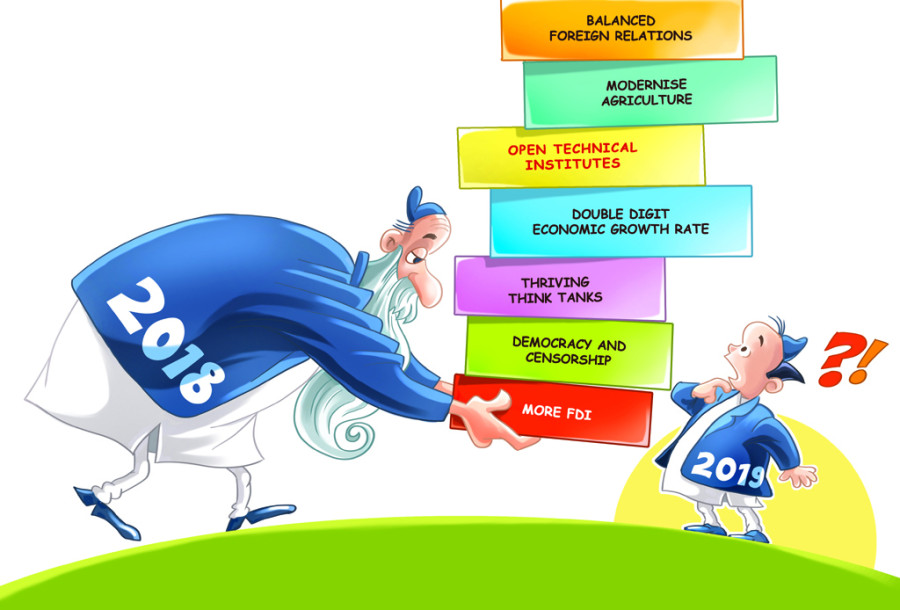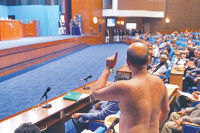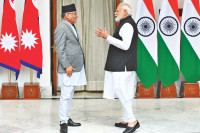Special Supplement
Why 2018 was the year of promises—some kept and many broken—for Nepal
Tangled in a series of ironies and contradictions, promises this year have simultaneously been broken and kept. For every swing forward on a promise, the government’s pendulum of change has swung back, revealing glaring chasms between progress and derailment.
The Kathmandu Post Editors
Following last year’s successful completion of a three-tiered election, 2018 began on a hopeful note—with a heap of neatly-packaged promises.
Nepal elected its first provincial governments, marking tangible strides to institutionalising federalism. KP Sharma Oli rose to power as an unapologetically brazen dream merchant—-touting strategic promises of development, prosperity, and deliverance. His electoral campaign prodigiously captured a public imagination that yearned for change and granted the left alliance with a comfortable two-thirds majority. Finally, the long wait for stability was over.
But 10 months later, there were many promises made but fewer results to show. Tangled in a series of ironies and contradictions, promises this year have simultaneously been broken and kept. For every swing forward on a promise, the government’s pendulum of change has swung back, revealing glaring chasms between progress and derailment.
To honour his promise of ‘good governance,’ Oli made several important interventions. Albeit late, mandatory progress reviews for ministerial teams reflected his demand for accountability. As the central government has only spent 11 percent of its budget while the provinces have spent less than 1 percent, these actions represent encouraging steps forward. The government took measures to develop independent monitoring systems through the installation of reviewing software on computers, indicating first steps towards e-governance.
The passing of 16 bills necessary to guarantee the fundamental rights enshrined in the constitution was a milestone as well. Although done in the nick of time, guaranteeing fundamental rights has given people a sense of security and confidence. But, at the same time, in the same garb of delivering on ‘good governance’, paternalism and moral policing has been legitimised. Through various legislative actions and directives, freedom of speech has been curtailed and censorship is on the rise. The government’s continued hurling of diktats over civil protests in public spaces and self-aggrandising efforts to limit criticism in public rhetoric has been an exercise in perceived authoritarianism.
From the enforcement of a new Civil Code that stipulates provisions for daughters to inherit shares of paternal property to passing laws on reproductive rights—this government has also claimed to act in the name of women’s rights and safety. Concurrently, it has continually dismissed and made a heartless farce out of another name: Nirmala Pant. The incompetence of the Nepal Police in investigating her rape-and-murder has revealed how the government’s promises of safety for women remain grossly unfulfilled. While paying lip-service to justice, the Nepal Police only added to human rights abuses by continually parading the wrong persons of interests, causing custodial deaths like that of Ram Manohar Yadav and regularly concealing facts for vested interests. At this rate, there is hardly anything for women to look forward to when it comes to their safety.
Nearly three years after the government’s announcement, the Oli administration was able to replace 105 out of 131 wire bridges with suspension bridges in remote districts of Nepal, denoting important steps towards addressing an issue that kills 100 Nepalis every year.
On the flipside, progress on large-scale pressing projects has repeatedly been abridged due to perpetual delays. The Minister for Water Supply promised the public that water from Melamchi would reach Kathmandu households by Dashain. Whether the promise was kept or not is for all to see—three months after the festival.
In a bid to usher in prosperity, the government also promised to adopt a policy of ‘zero tolerance against corruption’. But in the absence of robust implementation, such claims ring hollow. Be it a new law in the offing that would enable the government to bypass the public procurement process and pick developers for projects above Rs 50 billion without bids, continuing the practice of MPs and other officials at the Parliament secretariat channelling the salaries of their personal assistants into their own accounts, or misuse of public funds to purchase vehicles for the provincial government—examples abound. This government, then, is no different than the governments we have had in the past.
The government’s (over)emphasis on ‘maintaining national security’ has also manifested in several unprecedented initiatives such as the national biometric identification system, the push for a Digital Nepal, and the flagship social security scheme. The country was also at the forefront in leading global conversations over regional security by hosting large-scale conferences such as the BIMSTEC Summit. But the most pressing form of guaranteeing security—ensuring transitional justice—has continued to be held hostage to conflicting demands. Despite having only conducted preliminary investigations for 3,000 cases of more than 63,000 total complaints, the government is still undecided on whether to extend the terms of the Truth and Reconciliation Commission and the Commission of Investigation on Enforced Disappeared Persons.
Gains and losses were apparent on a diplomatic front, as well. Officials from China and Nepal were expected to meet by the end of this month to discuss the prospect of developing the much-hyped Kathmandu-Kerung railway line which would connect the two countries. This is a good beginning and noticeable progress has been made on this front. Yet, the onus undoubtedly lies on us when it comes to creating a pool of local experts so that our over-reliance on foreign experts can be minimised. Nepal’s relationship with India is also reflective of pre-2015 levels, with Indian Prime Minister Narendra Modi visiting Nepal twice—strengthening efforts to placate Nepalis after the blockade imbroglio. The railway track connecting Budhanagar, Biratnagar and Bathnaha, India was recently upgraded too. These are positive developments, but in a sharp retreat from his past approaches, Oli failed to talk tough with India on exchanging demonetised Indian currency notes. What’s more, the much-anticipated report of the Eminent Persons Group was completed and submitted to the prime ministers of Nepal and India respectively. But as reports surfaced over Modi’s reluctance to accept the report, the fate of the bilateral relation between Nepal and India remains uncertain.
At day 365, the heap of promises has stockpiled into a messier and more contradictory jumble. And in the process, the country has learned an invaluable lesson: securing a strong majority is no guarantee of the highest possible fulfilment of electoral and governmental promises. The legitimacy of a democratic government depends in large part on delivering on their promises, on keeping what has been agreed upon in election manifestos and government agreements, and on translating this into clear governmental action.
The same party that was lauded for staying ‘true to its word’ has appeared to show—in both promises kept and broken—that it can act contradictorily. For the next four years, the focus should be on ensuring that promises are few, they are concrete—and most importantly, they are kept.





 15.12°C Kathmandu
15.12°C Kathmandu








%20(1).jpg&w=300&height=200)

